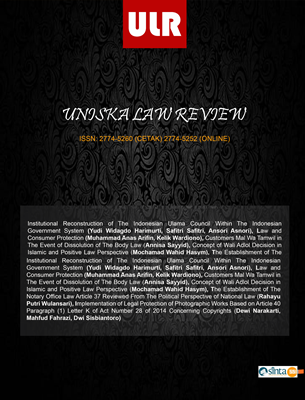The Party System Practices Within a Presidential Government System Based on The 1945 State Constitution of The Republic Of Indonesia Before and After The Amendments
Main Article Content
Abstract
Political parties are considered democratic institutions expected to help build a stable and democratic government. Conversely, political parties are often considered to trigger government instability. This study aims to 1) discover the history of the party system within General Elections in Indonesia and 2) investigate the influence of the multiparty political structure implemented in the presidential system. This normative legal article uses a historical approach to describe the party system history of some presidents and the House of Representatives before and after the amendment of the 1945 Constitution. Afterward, each history will be compared to investigate the comparison of the President's power relationship with the House of Representatives before and after the amendment of the 1945 Constitution. The findings showed that 1) the party system before the amendment (hereafter, the New Order) benefited the ongoing government. The president had no problems with political support because the government party was always the party supporting the government with an absolute majority in parliament. In contrast, the party system after the amendment (hereafter, multiparty politics) is considered a solution to maintain stability and balance in the ongoing political system. The president had some difficulties getting majority support from parliament, thus coalition between the president and political parties is a form of compromise. 2) The impact of a multiparty system is that the president indirectly allows parties outside him to influence his power structure. In conclusion, the problems of the presidential and multiparty system can be resolved with an accommodative and compromise presidential style of government.
Article Details
References
Jimly Asshidiqie, Konstitusi dan Konstitusionalisme, Konstitusi Press, Jakarta, 2005.
Abdul Mukhtie Fadjar, Partai Politik Dalam Perkembangan Ketatanegaraan di Indonesia, Setara Press, 2012, Malang.
Retno Saraswati, Desain Sistem Pemerintahan Presidensial yang Efektif, Masalah-Masalah Hukum, Jilid 4, No. 1, Januari 2012.
Firdaus, Desain Stabilitas Pemerintahan Demokrasi dan Sistem Kepartaian, Yrama Widya, Bandung, 2015.
Miriam Budiardjo, Dasar-Dasar Ilmu Politik, Edisi Revisi, Gramedia Pustaka Utama, Jakarta, 2010.
Ni’matul Huda dan M. Imam Nasef, Penataan Demokrasi dan Pemilu Di Indonesia Pasca Reformasi, Kencana, Jakarta, 2017.
2. Scientific Journal Articles
Eve Warburton dan Edward Aspinall, “Explaining Indonesia’s Democratic Regression,†Contemporary Southeast Asia 41, no. 2 (2019).
Efriza, Relasi Kekuasaan Presiden dan DPR dalam Sistem Presidensial, Jurnal Kajian Politik dan Masalah Pembangunan, VOL. 12 No. 02, 2016.
Scott Mainwaring, 1993, Presidentialism, Multiparty System, and Democracy: The Difficult Combination, Comparative Political Studies, Vol. 26 No. 2.
Djiwandono dalam Yuwanto, Parlemen Dan Demokratisasi: Peran Dewan Perwakilan Rakyat Dalam Transisi Demokrasi Di Indonesia, Jurnal Ilmiah Ilmu Pemerintahan, Vol 2, No. 2, 2016.
Hayat, Korelasi Pemilu Serentak dengan Multi Partai Sederhana Sebagai Penguatan Sistem Presidensial, Jurnal Konstitusi, Volume 11, Nomor 3, September 2014.
Syaefullah Eep Fatah, Praktik Presidensialisme Dan Demokrasi Indonesia, Jurnal Negarawan, No. 8, 2018, 2004.
Zuhdi Arman, Tinjauan Terhadap Sistem Multi Partai Dalam Sistem Pemerintahan Presidensial di Indonesia Pada Era Reformasi, Jurnal Cahaya Keadilan, Vol 6. No. 1, 2018.
Partono, Sistem Multi Partai, Presidensial dan Persoalan Efektifitas Pemerintah, Jurnal Legislasi Indonesia, Vol. 5, No.1, Maret 2008.
Putera Medea, Kekuasaan Presiden Ri Dalam Bidang Legislatif Setelah Amandemen Uud 1945, Lex Administratum, Vol.I, No.2, Apr-Jun 2013.
Sugiharto dalam Ahmad Depri Kurniawan Dkk, Pemikiran Politik Bj. Habibie Dalam Demokratisasi di Indonesia, Journal of Politics and Policy, Volume 3, Number 2, Juni 2021.
M. Yasin al-Arif, Anomali Sistem Pemerintahan Presidensial Pasca Amandemen UUD 1945, Jurnal Hukum Ius Quia Iustum, No. 2, Vol. 22, April 2015.
Fazrin Basalamah, Pengaruh Partai Politik Dalam Sistem Pemerintahan (Presidensial) Menurut Pasal 6A UUD 1945, Lex Administratum, Vol. VI, No. 2, Apr-Jun 2018.
Moch. Marsa Taufiqurrohman, Koalisi Partai Politik Dan Implikasinya Terhadap Sistem Presidensial Multipartai di Indonesia, Jurnal Kertha Semaya, Vol. 9, No. 1, 2020.
Isnaini, Koalisi Partai Politik Dalam Sistem Pemerintahan Presidensial Indonesia, CIVICUS: Pendidikan-Penelitian-Pengabdian Pendidikan Pancasila dan Kewarganegaraan, Vol. 8 No. 1 Maret 2020.
Haris dalam Asran Jalal, Sistem Presidensial Indonesia Masa Kepemimpinan Presiden Soesilo Bambang Yudhoyono (2004-2014), Jurnal Sosial dan Humaniora, Vol. 6, No. 2, 2021.
Lili Romli, Koalisi dan Konflik Internal Partai Politik pada Era Reformasi, Politica Vol. 8 No. 2 November 2017.
Lutfil Ansori, Pembentukan Kabinet Koalisi dalam Sistem Presidensial Multi Partai di Indonesia, Al Daulah Jurnal Hukum Pidana dan Ketatanegaraan, Vol. 12, No. 2, 2023.
3. Online Media
https://www.kpu.go.id/page/read/8/pemilu-1955
https://pusmendik.kemdikbud.go.id/asesmenpedia/public-subject/question-detail/b45165dc-5578-491d-8c96-c3e85a440aa1
https://www.kompas.com/tren/read/2022/06/07/084400665/sejarah-pemilu-pertama-di-era-reformasi-bagaimana-pelaksanaannya-?page=all
